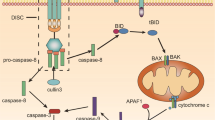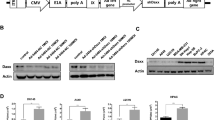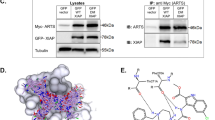Abstract
Apoptin has been described to induce apoptosis in various human cancer cell lines, but not in normal cells, thus making it an interesting candidate for the development of novel therapeutic strategies. Apoptin was generated and cloned into several mammalian expression vectors. Transfection or microinjection of apoptin cDNA resulted in its expression, initially in the cytoplasm with a filamentous pattern. Subsequently, apoptin entered the nucleus and efficiently induced apoptosis in several cancer cell lines. Nuclear localization was shown to be required for induction of apoptosis. Apoptin expression level was found to be an important determinant of the efficiency of induction of apoptosis. Surprisingly, expression of apoptin or GFP-apoptin cDNA induced apoptosis in some normal cells. When fused to the HIV-TAT protein transduction domain and delivered as a protein, TAT-apoptin was transduced efficiently (>90%) into normal and tumour cells. However, TAT-apoptin remained in the cytoplasm and did not kill normal 6689 and 1BR3 fibroblasts. In contrast TAT-apoptin migrated from the cytoplasm to the nucleus of Saos-2 and HSC-3 cancer cells resulting in apoptosis after 24 h. This study shows that apoptin is a powerful apoptosis-inducing protein with a potential for cancer therapy.
This is a preview of subscription content, access via your institution
Access options
Subscribe to this journal
Receive 50 print issues and online access
$259.00 per year
only $5.18 per issue
Buy this article
- Purchase on Springer Link
- Instant access to full article PDF
Prices may be subject to local taxes which are calculated during checkout







Similar content being viewed by others
References
Becker-Hapak M, McAllister SS and Dowdy SF . (2001). Methods, 24, 247–256.
Cohen JJ . (1993). Immunol Today, 14, 126–130.
Danen-Van Oorschot AA, Fischer DF, Grimbergen JM, Klein B, Zhuang S, Falkenburg JH, Backendorf C, Quax PH, Van der Eb AJ and Noteborn MH . (1997). Proc Natl Acad Sci USA, 94, 5843–5847.
Danen-van Oorschot AA, van Der Eb AJ and Noteborn MH . (2000). J Virol, 74, 7072–7078.
Danen-Van Oorschot AA, Zhang Y, Erkeland SJ, Fischer DF, van der Eb AJ and Noteborn MH . (1999). Leukemia, 13 (Suppl 1), S75–S77.
Danen-Van Oorschot AA, Zhang YH, Leliveld SR, Rohn JL, Seelen MC, Bolk MW, Van Zon A, Erkeland SJ, Abrahams JP, Mumberg D and Noteborn MH . (2003). J Biol Chem, 278, 27729–27736.
Flinterman M, Gaken J, Farzaneh F and Tavassoli M . (2003). Oncogene, 22, 1965–1977.
Ford KG, Souberbielle BE, Darling D and Farzaneh F . (2001). Gene Ther, 8, 1–4.
Gius DR, Ezhevsky SA, Becker-Hapak M, Nagahara H, Wei MC and Dowdy SF . (1999). Cancer Res, 59, 2577–2580.
Holme TC . (1990). Eur J Surg Oncol, 16, 161–169.
Janicke RU, Sprengart ML, Wati MR and Porter AG . (1998). J Biol Chem, 273, 9357–9360.
Mann DA and Frankel AD . (1991). Embo J, 10, 1733–1739.
Meehan BM, Todd D, Creelan JL, Earle JA, Hoey EM and McNulty MS . (1992). Arch Virol, 124, 301–319.
Nagahara H, Vocero-Akbani AM, Snyder EL, Ho A, Latham DG, Lissy NA, Becker-Hapak M, Ezhevsky SA and Dowdy SF . (1998). Nat Med, 4, 1449–1452.
Noteborn MH, de Boer GF, van Roozelaar DJ, Karreman C, Kranenburg O, Vos JG, Jeurissen SH, Hoeben RC, Zantema A and Koch G et al. (1991). J Virol, 65, 3131–3139.
Noteborn MH, Todd D, Verschueren CA, de Gauw HW, Curran WL, Veldkamp S, Douglas AJ, McNulty MS, van der EA and Koch G . (1994). J Virol, 68, 346–351.
Noteborn MH, Zhang YH and van der Eb AJ . (1998). Mutat Res, 400, 447–455.
Rohn JL, Zhang YH, Aalbers RI, Otto N, Den Hertog J, Henriquez NV, Van De Velde CJ, Kuppen PJ, Mumberg D, Donner P and Noteborn MH . (2002). J Biol Chem, 277, 50820–50827.
Schwarze SR, Ho A, Vocero-Akbani A and Dowdy SF . (1999). Science, 285, 1569–1572.
Schwarze SR, Hruska KA and Dowdy SF . (2000). Trends Cell Biol, 10, 290–295.
Siegel RM, Martin DA, Zheng L, Ng SY, Bertin J, Cohen J and Lenardo MJ . (1998). J Cell Biol, 141, 1243–1253.
Vives E, Brodin P and Lebleu B . (1997). J Biol Chem, 272, 16010–16017.
Vocero-Akbani AM, Heyden NV, Lissy NA, Ratner L and Dowdy SF . (1999). Nat Med, 5, 29–33.
Weber CH and Vincenz C . (2001). Trends Biochem Sci, 26, 475–481.
Zhang YH, Abrahams PJ, van der Eb AJ and Noteborn MH . (1999). Cancer Res, 59, 3010–3015.
Zhuang SM, Landegent JE, Verschueren CA, Falkenburg JH, van Ormondt H, van der Eb AJ and Noteborn MH . (1995a). Leukemia, 9 (Suppl 1), S118–S120.
Zhuang SM, Shvarts A, Jochemsen AG, van Oorschot AA, van der Eb AJ and Noteborn MH . (1995b). Carcinogenesis, 16, 2939–2944.
Zhuang SM, Shvarts A, van Ormondt H, Jochemsen AG, van der Eb AJ and Noteborn MH . (1995c). Cancer Res, 55, 486–489.
Acknowledgements
We are grateful to Dr Daniel Todd (Department of Agriculture and Rural Development for Northern Ireland, the Queen's University of Belfast) for providing pCAA-3 and anti-VP3 monoclonal antibody and for very useful discussions. We are grateful to Dr Steven F Dowdy (Howard Hughes Medical Institute, Department of Pathology, Washington University School of Medicine) for providing pTAT-HA and pTAT-HA-GFP, to Dr Alan Lehmann (MRC Cell Mutation Unit, University of Sussex) for 1BR3 and 1BR3N cells, to Dr Martin Dyer (MRC Toxicology Unit, University of Leicester) for pGFP-Bcl10 and Dr Richard Siegel (NIAID NIH Bethesda) for pFADD-GFP. This study was supported by a grant from the BBSRC (47/GTH12530).
Author information
Authors and Affiliations
Corresponding author
Rights and permissions
About this article
Cite this article
Guelen, L., Paterson, H., Gäken, J. et al. TAT-apoptin is efficiently delivered and induces apoptosis in cancer cells. Oncogene 23, 1153–1165 (2004). https://doi.org/10.1038/sj.onc.1207224
Received:
Revised:
Accepted:
Published:
Issue Date:
DOI: https://doi.org/10.1038/sj.onc.1207224
Keywords
This article is cited by
-
A novel anti-CD22 scFv–apoptin fusion protein induces apoptosis in malignant B-cells
AMB Express (2017)
-
Novel characteristics of the avian gyrovirus 2 genome
Scientific Reports (2017)
-
A truncated apoptin protein variant selectively kills cancer cells
Investigational New Drugs (2017)
-
The chimeric multi-domain proteins mediating specific DNA transfer for hepatocellular carcinoma treatment
Cancer Cell International (2016)
-
Viral genes as oncolytic agents for cancer therapy
Cellular and Molecular Life Sciences (2015)



